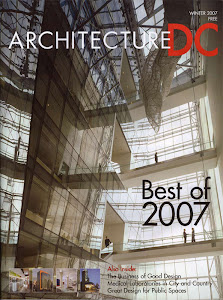skip to main |
skip to sidebar


Spotting modern design on my jaunts around the city are always an exciting part of my day. I recently discovered two newer projects in a neighborhood that I had least expected to see them in. The area North of Georgetown, Glover Park, consists of rows upon rows of late 1920's-1940's townhouses. They all are variations on a theme based on simple colonial and Georgian styles. Traditional, functional, and accommodating are the descriptions that come to mind with these houses. The first modern example are two side by side residences that were recently constructed in the middle of one of the above mentioned rows of classic decades old American housing. At first glance, you absolutely cannot miss it, as it looms over the rest of the block as if a giant modernist house fell out of the sky and landed in the middle of this unsuspecting block. The consistency of the row was dramatically broken up by the modern intervention. The design thrusts the houses to the street edge, where most of the other houses on the block are set back to allow for a substantial front yard. The existing houses are all two storys, while the new is maxed out at almost four. The house looks as though it was ballooned to the extents of the building lot and height limitations. It is what I would consider contextually inconsiderate. While the various materials that clad the exterior are sleek and beautiful, none relate to the original palate of the street. If this house had been designed more sensitive to the neighborhood scale, proportion, and materiality, it definitely would have been a more integrated modern approach to the row houses on the block. The interplay between large glazed areas and textural cladding gives interest to the front elevation. One half comes further forward the the other half, shifting the overall massing. The half set back from the street edge is screened along the front with a system of metal cabling and rails. This softens the heaviness of the overall elevation and adds a nice layer of screening to the full glass wall behind. The interior living spaces are designed to be open and full of light. This concept translates to the front elevation but not to the overall massing. Had the design of the front elevation been further edited and translated to the other sides of the house, and had the massing been minimized to create less of a juxtaposition to the existing neighbors, it would have been a very successful modern addition to the neighborhood. 










No comments:
Post a Comment